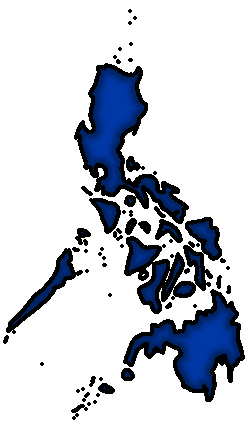Republic of the Philippines / Republika ng Pilipinas

| Nickname | Pearl of the Orient |
| Population (2023) | ~114.9 million |
| Official Language | Filipino, English |
| Capital | Manila |
| Currency | Peso (₱) |
| System of Government | Representative democracy |
| National Symbols | Arabian jasmine/sampaguita, carabao (buffalo), Arnis (Philippine martial arts) |
Maligayang pagdating!!
The Philippines is an archipelago nation meaning it exists out of a large string of islands (around 7000). It's entirely surrounded by the Philippine Sea, and it's largest islands, Luzon (northern island on the image) and Mindanao (southern island) make up around 60% of its total land area alone.
Ethnic Makeup
The main four ethnic groups which together make up the majority of the population are Taglog, Visayan, Ilocano, Bikolano. Others include Moro, Lumad, Negritos, Chinese Filipinos, Spanish and Mestizos (half-caste).
Taglog
Account for around 28% of the total population and primarily live in the island of Luzon which houses the capital, Manila. The national language of the Philippines is based on the Taglog language.
Visayan
Visayan is a group of multiple ethnicites and combined make up for around 31% of the total population. Before the arrival of Spain they were heavy into animism and known for their tattoos (pintados) and golden jewelry though are today are majority Catholic like the rest of the Filipino population.
Ilocanos
Ilocanos make up for around 8% of the total population and live in the northwest of Luzon (Ilocos region). They're known for resisting Spanish rule heavily, frequently revolting and engaging the Spanish with skimrishes and raids.
Bicolano
Bicolanos have around a 7% share of the total populationa and live in the southeast of Luzon on the Bicol peninsula + have a sizeable community based in Mindanao. Different to the Ilocanos yet both got their name coined by the Spanish. 'Bico' refers to Bikol (possibly from bikod which = meandering, following a winding course) while 'Iloco' is derived from 'loóc' (bay).
Spain
Ferdinand Magellan was a Portugese sailor who served under the Spanish crown. Magellan and his crew sailed under South America, crossed the Pacific and eventually reached the other side of the world. He landed on Cebu island on the 16th of March, 1521 and wanted to claim the islands for Spain aswell as convert the local leaders to Christianity though this would be his last act since he died in April of the same year at the battle of Mactan, killed by chieftan Datu Lapulapu.
After Magellan's death Spain tried, on various occasions, to colonize the Philippines though all of these early attempts failed due to supply shortage (Philippines was far away from Spain and her colonies), Portugal engaging Spain out of fear that Spain would gain a foothold in Asia and Filipino resistance. One of these attempts was led by Ruy López de Villalobos in 1543 who first used the term 'Las Islas Filipinas', named after the then-prince Philip II of Spain (1527-1598).
updates
6/7/25 - created the philippines page
Colonization
In 1565 Spain set up a permanent settlement under leadership of Miguel López de Legazpi with Spanish and native Mexican sailors and explorers who departed from Mexico. They arrived on the island of Cebu and named the foothold San Miguel which would later be renamed to Villa del Santísimo Nombre de Jesús, today Cebu City. Spain would eventually go on to conquer the entire archipelago and hold onto it for some 333 years.